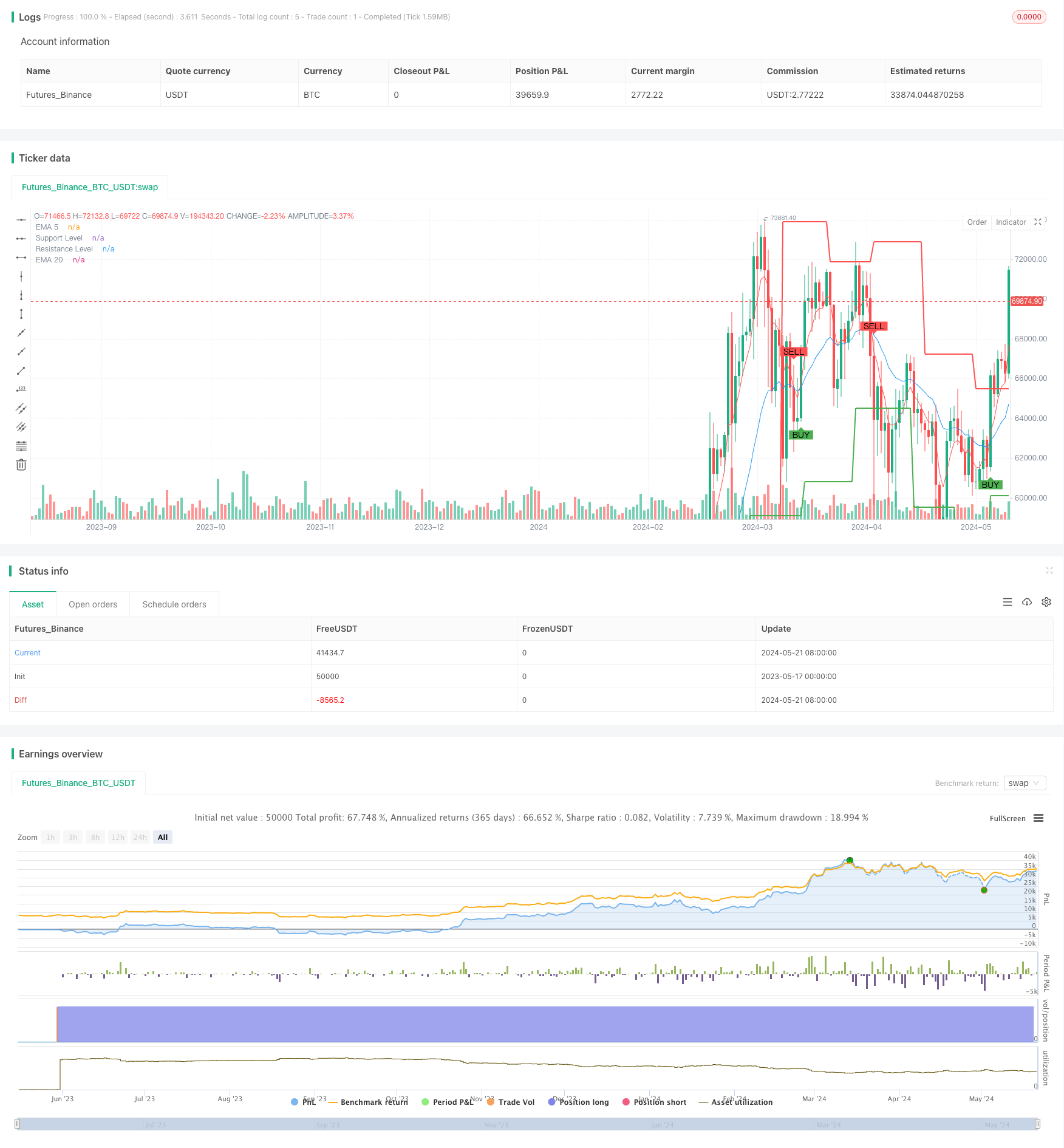
概述
SMK ULTRA TREND 双均线交叉策略是一种基于5日指数移动平均线(EMA5)和20日指数移动平均线(EMA20)的交叉信号产生交易信号的量化交易策略。该策略的核心思想是利用短期均线和中期均线的交叉来捕捉市场趋势的变化,当EMA5上穿EMA20时产生买入信号,当EMA5下穿EMA20时产生卖出信号。同时,该策略还结合了支撑位和阻力位的概念,通过在图表上绘制支撑线和阻力线来辅助判断趋势的走向和强度。
策略原理
SMK ULTRA TREND 双均线交叉策略的原理可以概括为以下几个步骤: 1. 计算5日EMA和20日EMA。EMA相比于简单移动平均线(SMA)能够更快地对价格变化做出反应,更适合用于捕捉短期趋势。 2. 判断EMA5和EMA20的交叉情况。当EMA5上穿EMA20时,产生买入信号;当EMA5下穿EMA20时,产生卖出信号。 3. 计算支撑位和阻力位。通过识别过去5个交易日的最低价和最高价来确定支撑位和阻力位。 4. 在图表上绘制EMA5、EMA20、支撑线和阻力线,直观地展示策略信号和关键价位。 5. 根据交叉信号执行交易。买入信号出现时开多仓,卖出信号出现时平仓。
策略优势
- 简单易用:该策略逻辑清晰,使用的指标简单,计算方法易于理解和实现,适合量化交易新手学习使用。
- 适应性强:双均线交叉策略可以应用于多个交易品种和多个时间周期,通过调整均线周期参数,可以灵活适应不同的市场特点和交易风格。
- 趋势跟踪:EMA指标相比SMA更重视近期价格变化,能够及时反映价格趋势的变化,有助于顺势而为。
- 支撑阻力辅助判断:引入支撑线和阻力线,可以更好地把握趋势强度和潜在的变盘时机,为交易决策提供更多参考。
策略风险
- 频繁交易:该策略基于短期均线交叉产生信号,在震荡市场中可能会出现频繁交易的情况,增加交易成本和回撤风险。
- 滞后性:作为一个趋势跟踪策略,双均线交叉策略难免存在一定的滞后性,可能错过趋势启动的最佳时机,或者在趋势反转时延迟出场。
- 假信号:在市场噪音较大的情况下,均线交叉可能产生一些假信号,导致策略表现不佳。
策略优化方向
- 信号过滤:在均线交叉的基础上,引入其他技术指标如RSI、MACD等,对交易信号进行二次确认,提高信号的可靠性。
- 动态参数优化:根据市场状况和品种特点,对均线周期参数进行动态调整,使策略更好地适应市场节奏的变化。
- 仓位管理:根据趋势强度、波动率等指标,对仓位进行动态调整,在趋势强劲时加大仓位,在趋势不明朗或风险加大时减小仓位。
- 止损止盈:设置合理的止损位和止盈目标,控制单笔交易的风险敞口,提高策略的风险收益比。
总结
SMK ULTRA TREND 双均线交叉策略是一个简单实用的量化交易策略,通过EMA5和EMA20的交叉信号来捕捉市场趋势,同时结合支撑线和阻力线等辅助工具,为交易决策提供参考。该策略优点是逻辑清晰,适应性强,易于实现和优化;缺点是在震荡市场中可能出现频繁交易和假信号,需要通过信号过滤、参数优化、仓位管理、止损止盈等方式来改进策略表现,提高策略的稳健性和盈利能力。
策略源码
/*backtest
start: 2023-05-17 00:00:00
end: 2024-05-22 00:00:00
period: 1d
basePeriod: 1h
exchanges: [{"eid":"Futures_Binance","currency":"BTC_USDT"}]
*/
//@version=5
strategy("SMK ULTRA TREND STRATEGY", overlay=true)
// Define the length for EMAs
ema5_length = 5
ema20_length = 20
// Calculate EMAs
ema5 = ta.ema(close, ema5_length)
ema20 = ta.ema(close, ema20_length)
// Plot EMAs
plot(ema5, title="EMA 5", color=color.red )
plot(ema20, title="EMA 20", color=color.blue)
// Generate buy and sell signals
buySignal = ta.crossover(ema5, ema20)
sellSignal = ta.crossunder(ema5, ema20)
// Plot buy and sell signals
plotshape(series=buySignal, location=location.belowbar, color=color.green, style=shape.labelup, text="BUY")
plotshape(series=sellSignal, location=location.abovebar, color=color.red, style=shape.labeldown, text="SELL")
// Execute buy and sell orders
if (buySignal)
strategy.entry("Buy", strategy.long)
if (sellSignal)
strategy.close("sell")
// Define support and resistance lengths
pivotLen = 5
// Calculate support and resistance levels
var float supportLevel = na
var float resistanceLevel = na
if (ta.pivotlow(low, pivotLen, pivotLen))
supportLevel := low[pivotLen]
if (ta.pivothigh(high, pivotLen, pivotLen))
resistanceLevel := high[pivotLen]
// Plot support and resistance levels
plot(supportLevel, title="Support Level", color=color.green, linewidth=2, style=plot.style_linebr)
plot(resistanceLevel, title="Resistance Level", color=color.red, linewidth=2, style=plot.style_linebr)
相关推荐